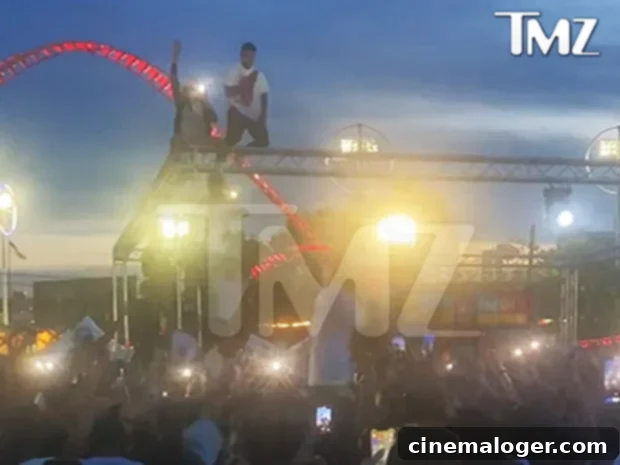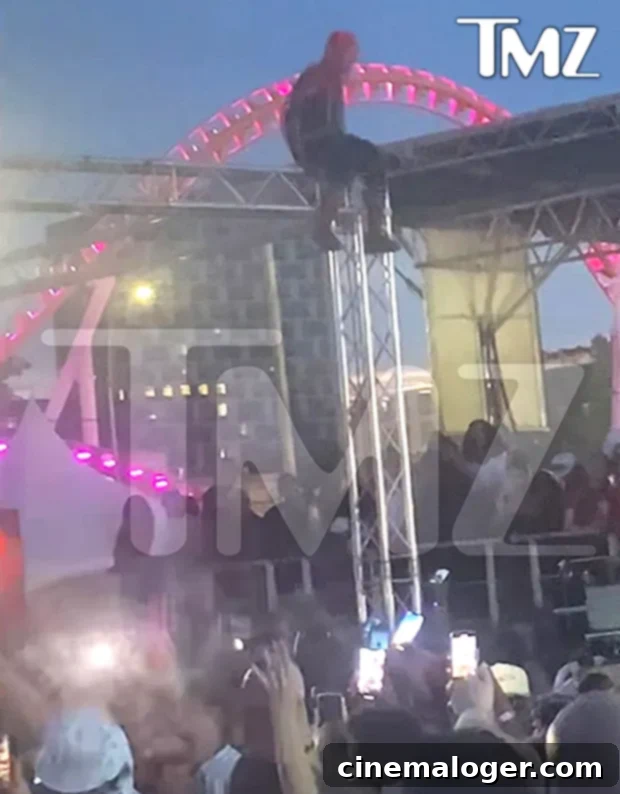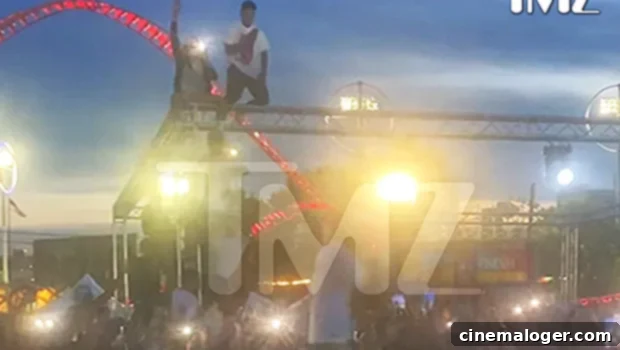Fan Safety First: Travis Scott Halts NYC Concert Amidst Onstage Climbs and Crowd Concerns
In a significant display of heightened awareness and proactive crowd management, acclaimed rapper Travis Scott paused his highly anticipated performance in New York City on Monday, July 4. The incident unfolded at Coney Island, where Scott took decisive action to address unruly fans who had begun scaling metal structures and pressing dangerously close to the stage barricades. This cautionary move comes less than a year after the tragic Astroworld Music Festival, an event that resulted in 10 fatalities and intense scrutiny of Scott’s handling of concert safety.
Footage of the Coney Island concert, widely circulated by TMZ, clearly shows Travis Scott halting his set to directly communicate with the audience. As several fans were seen precariously climbing the stage’s metal scaffolding and truss, the 31-year-old artist immediately intervened, prioritizing their safety. His words were firm yet concerned: “We need y’all to get down,” he urged. “My brother, just make sure you’re okay.” At another critical moment, he was distinctly heard instructing another individual, emphasizing, “You gotta get down.” This direct engagement marked a clear departure from the criticisms he faced regarding crowd control at previous events, signaling a conscious effort to ensure a secure environment for all attendees.

Beyond addressing those climbing the stage infrastructure, Scott also focused on the general crowd dynamics. In a separate segment of the performance, he could be heard calmly but resolutely instructing fans to “relax” and to “back up” from the barricade. He implored his audience to take a few steps back from the stage perimeter, creating a safer buffer zone. Crucially, he extended this caution to the security personnel present, urging them against aggressive crowd management tactics. “Everybody right here, take two steps back,” he commanded. “Security, do not push them. Don’t push it. Don’t push the barricade.” This directive highlighted a holistic approach to crowd safety, acknowledging both fan behavior and the methods employed by event staff, aiming to prevent potential crush situations or unwarranted confrontations.
The Coney Island performance unfolded just months after the devastating Astroworld Festival in November 2021, an event that cast a long shadow over Travis Scott’s career and the entire live music industry. The festival, held in Houston, Texas, turned into a scene of tragedy when a deadly crowd surge led to the deaths of 10 attendees and left hundreds injured. The sheer scale of the incident led to an unprecedented number of lawsuits, massive public criticism directed at Scott, festival organizers, and Live Nation, and a widespread reevaluation of concert safety protocols. For months following Astroworld, Travis Scott largely retreated from the public eye, his professional activities significantly curtailed as he grappled with the fallout of the tragedy.
The path back to live performances has been a cautious and measured one for Scott. His first unannounced public appearance post-Astroworld was at a Coachella afterparty in April, a tentative step back into the spotlight. This was followed by his return to scheduled performances, including a club appearance in Miami. A more prominent milestone was his first televised performance at the Billboard Music Awards in May, where he performed his tracks “Too Much Power” and “MAFIA.” Each of these appearances has been met with intense scrutiny, with fans and critics alike watching closely to see how Scott addresses the past and implements new safety measures. His actions at the Coney Island show are therefore not isolated but part of a larger narrative of conscious recalibration and an evident commitment to preventing a recurrence of previous disasters.

In direct response to the Astroworld tragedy and as a testament to his commitment to transforming concert environments, Travis Scott launched the Project HEAL initiative. This ambitious multi-tier community-focused project aims to make live events safer and more enjoyable for everyone. Project HEAL focuses on several key pillars: providing scholarships for college students, funding mental health resources for young people, and crucially, implementing an extensive event safety initiative. This includes investing in technology for crowd control, developing comprehensive safety plans, and collaborating with experts to ensure that future concerts prioritize attendee well-being above all else. The initiative reflects a significant investment not just of finances, but of Scott’s personal brand and influence, into fostering a culture of responsibility and prevention within the live entertainment sector. It signifies a profound understanding of the need for systemic change rather than merely reactive measures.
The live music industry as a whole has been forced to confront uncomfortable truths about crowd management, artist responsibility, and overall event security in the wake of incidents like Astroworld. Travis Scott’s actions at Coney Island, therefore, resonate far beyond a single performance. They serve as a vivid illustration of the shift towards more vigilant and proactive approaches to fan safety. Artists, promoters, and venue operators are now under increased pressure to implement robust safety protocols, including clear communication channels, effective crowd control mechanisms, and visible medical and security presences. The incident highlights a collective responsibility to educate fans about safe concert behavior and to create environments where passion for music does not compromise personal safety. The balance between maintaining the energetic atmosphere characteristic of a Travis Scott show and ensuring the well-being of thousands of attendees remains a critical challenge, but one that artists and organizers are increasingly expected to master.
Looking ahead, Travis Scott is scheduled for more concerts in the coming months, including two appearances in London and three shows at the Primavera Sound music festival. These upcoming performances will undoubtedly be watched with the same close attention given to his New York appearance. His demonstrated commitment to stopping a show when safety is compromised sends a powerful message that the lessons from Astroworld have been taken to heart. It underscores a hopeful evolution towards a future where the exhilaration of live music can be experienced without fear, with artist intervention and robust safety measures becoming standard practice rather than exceptions. The proactive stance taken at Coney Island is a pivotal moment, not only for Travis Scott’s career rehabilitation but also for setting a new precedent in concert safety across the global music landscape.
